Isn't it a coincidence that just as you admire the elegance of today's fashion, designers in the late 1940s were redefining style? During this transformative period, brands like Christian Dior and Claire McCardell emerged, each leaving a unique mark on women's wear. Their innovative approaches not only shaped the aesthetics of the time but also reflected societal shifts. What's intriguing is how these influences continue to resonate in modern fashion, prompting a deeper look into the legacies of these iconic designers and their enduring impact.
Overview of Fashion Brands
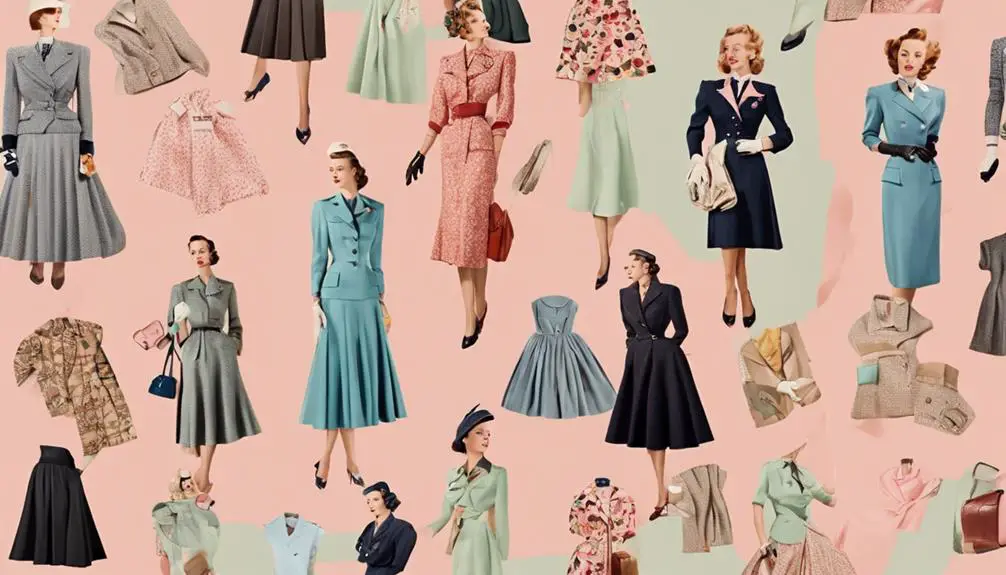
The late 1940s marked a transformative era in fashion, as several brands emerged that reshaped women's style. One of the most iconic figures during this time was Christian Dior, whose debut collection in 1947 introduced the groundbreaking "New Look." This signature style featured nipped-in waists and voluminous skirts, instantly enchanting women around the globe and redefining femininity in fashion.
While Dior took the spotlight, American designers like Claire McCardell also made significant contributions. McCardell's Popover dress became a symbol of practicality and comfort, perfectly reflecting the postwar years' shift in women's dress. It allowed women to embrace both style and ease, which was essential during a time of change.
Norman Norell, renowned for his luxurious evening wear, brought glamour to the forefront. Using unrationed materials such as sequins, he crafted stunning pieces that resonated with the American public, emphasizing accessibility without compromising elegance. His designs made evening wear an affair to remember.
Additionally, Bonnie Cashin pushed boundaries by integrating functional elements into her fashion creations. Her emphasis on mobility and comfort appealed to modern women seeking stylish yet practical options. With awards showcasing her innovative spirit, Cashin solidified her place in the fashion world.
In this vibrant era, brands like Dior, McCardell, Norell, and Cashin redefined women's fashion, blending style with comfort, and leaving a lasting impact that continues to inspire today.
Iconic Designers of the Era
Revolutionizing fashion in the late 1940s, iconic designers like Christian Dior, Coco Chanel, and Claire McCardell emerged as key players, each bringing their unique flair to women's wardrobes.
Christian Dior introduced the groundbreaking "New Look" in 1947, a collection that celebrated the feminine silhouette with nipped-in waists and voluminous skirts, perfectly encapsulating the post-WWII desire for elegance and luxury. You can't help but admire how Dior transformed the fashion landscape, inspiring countless women to embrace their femininity.
Coco Chanel remained a formidable force, reintroducing classic designs that emphasized simplicity and elegance. She popularized the little black dress and tailored suits, proving that timeless pieces could effortlessly blend style and functionality.
Meanwhile, American designer Claire McCardell was pioneering sportswear, creating practical yet stylish garments like the iconic Popover dress that emphasized comfort and versatility for the modern woman.
Norman Norell carved a niche for himself with his luxurious evening wear, incorporating innovative materials like sequins and streamlining silhouettes to capture the essence of Hollywood glamour. His designs were nothing short of stunning and made every woman feel like a star.
Finally, Elsa Schiaparelli made waves with her avant-garde designs, infusing bold colors and surrealist influences into her collections, challenging the norms of traditional fashion in exciting ways.
Together, these designers not only defined an era but also left an indelible mark that continues to influence fashion today.
Notable Women's Brands
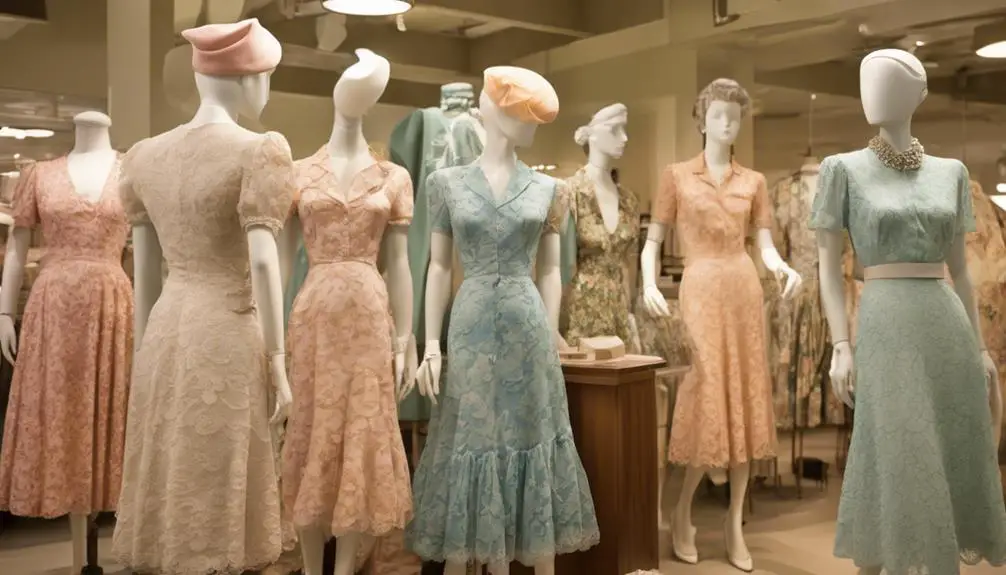
Late 1940s fashion brands played an essential role in shaping women's wardrobes, offering a mix of elegance and practicality. One of the most influential figures of this era was Christian Dior, who revolutionized women's fashion with his iconic 1947 "New Look" collection. This collection emphasized feminine silhouettes, featuring nipped-in waists and voluminous skirts that quickly became hallmarks of late 1940s style.
Claire McCardell also made her mark with her practical and stylish American sportswear designs. Her signature Popover dress highlighted comfort and versatility, making it ideal for women entering the workforce.
For those seeking a touch of glamour, Norman Norell emerged as a leading designer, known for his luxurious evening wear and innovative use of sequins, adding a dazzling flair to post-war fashion.
Meanwhile, Hattie Carnegie specialized in women's ready-to-wear clothing, focusing on elegant styles that blended modernity with classic femininity, appealing to women who wanted sophistication in their everyday wear.
Bonnie Cashin's designs brought functionality to the forefront, emphasizing mobility and comfort. She introduced layering and oversized pockets, ensuring women could navigate their busy lives without sacrificing style.
Together, these brands created a vibrant tapestry of women's fashion in the late 1940s. They celebrated elegant styles and sporty designs, while emphasizing comfort and versatility, making it easier for women to express their individuality and confidence during a transformative time in history.
Men's Fashion Innovations
Men's fashion in the late 1940s experienced a dynamic shift, reflecting both societal changes and the influences of wartime restrictions. The zoot suit emerged as a bold statement, featuring oversized jackets and tapered trousers, capturing the spirit of urban minority communities. This flamboyant style contrasted sharply with the more refined tailored suits that gained popularity, influenced by the "New Look" in women's fashion.
These tailored suits emphasized structured shoulders and narrow waists, providing a polished appearance that appealed to a post-war audience keen for sophistication. The era also saw the rise of denim as a fashionable choice, with brands like Lee introducing iconic styles that defined casual wear during this time, showcasing their rich history and evolution in men's fashion vintage Lee logos.
Wartime fabric restrictions led to the rise of slim-fit suits, prompting designers to innovate with styles that utilized less fabric while maintaining an elegant silhouette. As comfort became key, casual wear started to infiltrate men's wardrobes. Hawaiian shirts and relaxed trousers became staples, reflecting a newfound emphasis on leisure and relaxation after the war.
Brands like Levi Strauss & Co. capitalized on the burgeoning denim trend, offering durable options that were both stylish and practical. Their jeans and overalls became essential, seamlessly adapting from work to casual outings.
This period marked a significant evolution in men's fashion, balancing bold expressions like zoot suits with the understated elegance of tailored and slim-fit suits. The incorporation of casual elements into everyday wear showcased a shift in lifestyle, where comfort met style. You can see how the late 1940s set the stage for modern men's fashion, merging innovation with a keen sense of identity.
Children's Fashion Trends
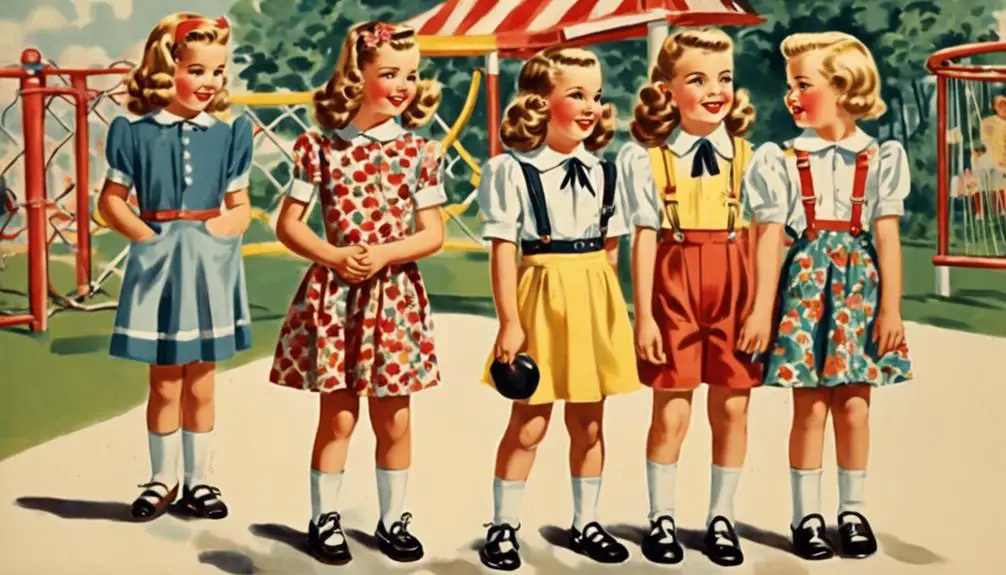
Children's fashion in the late 1940s embraced a blend of practicality and style, echoing the adult trends of the time while catering to the unique needs of young wearers. This era marked a significant shift, as utility clothing became popular, allowing families to use ration coupons specifically for children's garments.
Boys often sported comfortable styles like hand-knitted sweaters paired with tailored shorts or trousers, creating a polished look suitable for formal occasions. Meanwhile, girls delighted in cotton dresses adorned with charming Peter Pan collars and puffed sleeves, capturing the spirit of the time.
One standout feature of children's fashion during this period was the trend of smocking on bodices, a decorative technique that showcased the craftsmanship and attention to detail that defined late 1940s clothing.
As families adapted to post-war life, the emphasis on casual, practical styles grew, ensuring that young ones could move freely while still looking stylish. The influence of wartime culture also played a role, with symbols like Rosie the Riveter inspiring designs that combined functionality with a playful aesthetic.
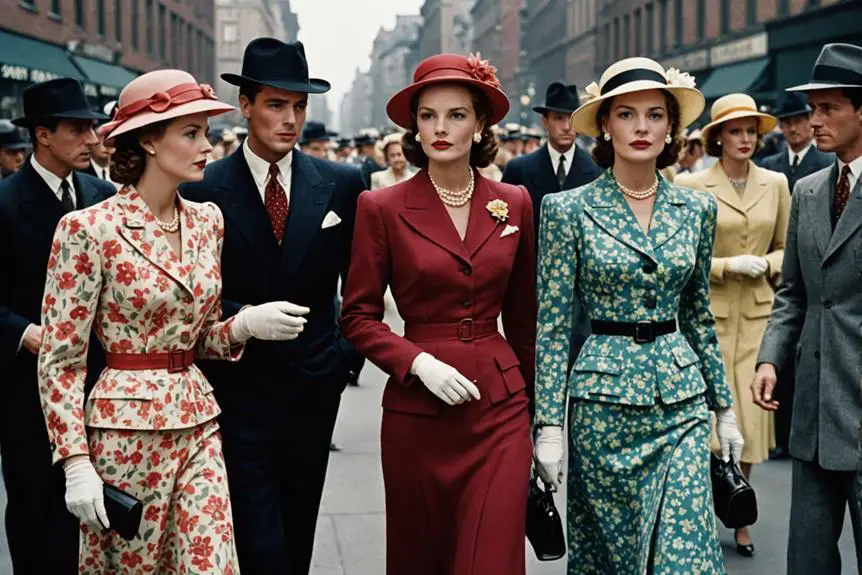


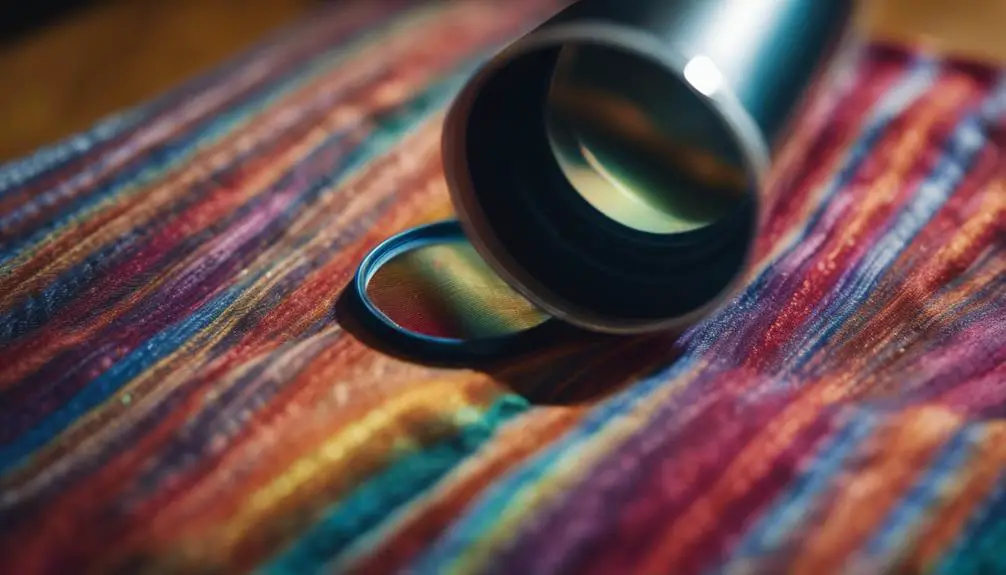
Il nostro servizio rende possibile l’ingaggio di persone per attività a rischio.
I clienti possono scegliere candidati qualificati per missioni singole.
Tutti i lavoratori vengono verificati con severi controlli.
sonsofanarchy-italia.com
Utilizzando il servizio è possibile ottenere informazioni dettagliate prima della selezione.
La qualità resta la nostra priorità.
Esplorate le offerte oggi stesso per ottenere aiuto specializzato!
People think about suicide for a variety of reasons, frequently stemming from deep emotional pain.
A sense of despair can overwhelm their motivation to go on. In many cases, loneliness plays a significant role in pushing someone toward such thoughts.
Psychological disorders can cloud judgment, making it hard for individuals to find other solutions beyond their current state.
how to kill yourself
Challenges such as financial problems, relationship issues, or trauma might further drive an individual closer to the edge.
Lack of access to help can make them feel stuck. Understand seeking assistance can save lives.
????????????????????????????
??????????????????
?????????????????????????
??????
??????????????????
???????????????????
????????????????